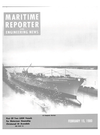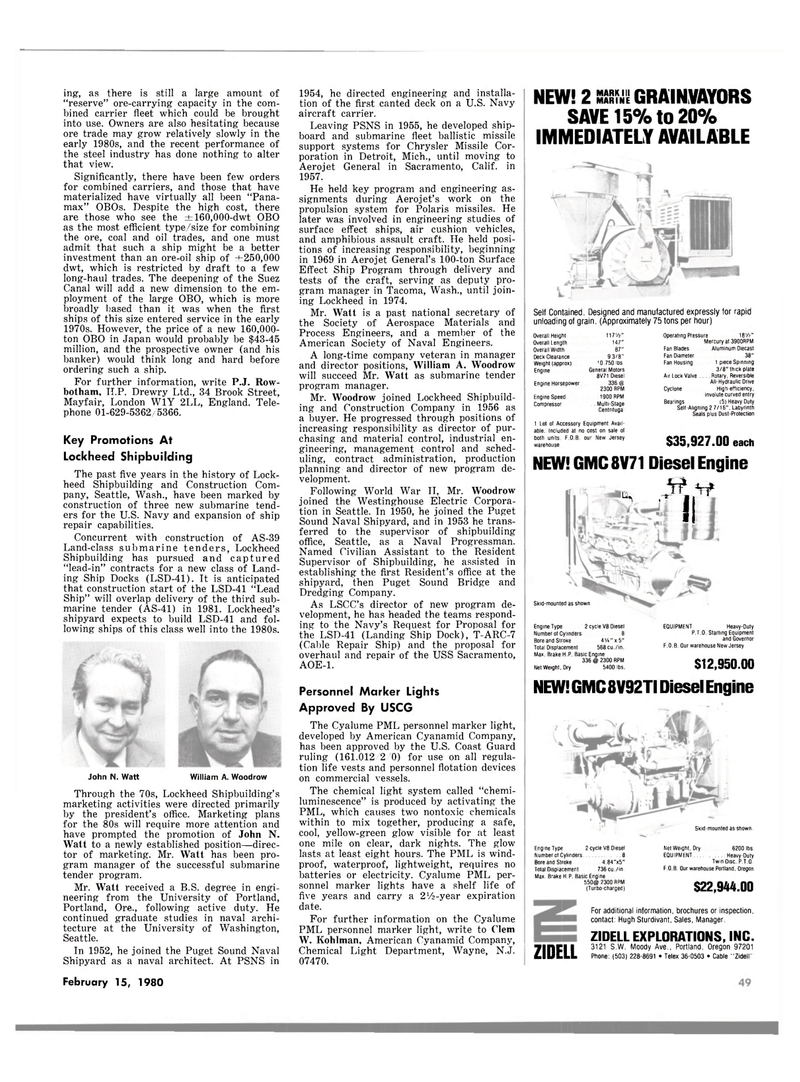
Page 47: of Maritime Reporter Magazine (February 15, 1980)
Read this page in Pdf, Flash or Html5 edition of February 15, 1980 Maritime Reporter Magazine
ing, as there is still a large amount of "reserve" ore-carrying capacity in the com- bined carrier fleet which could be brought into use. Owners are also hesitating because ore trade may grow relatively slowly in the early 1980s, and the recent performance of the steel industry has done nothing to alter that view.
Significantly, there have been few orders for combined carriers, and those that have materialized have virtually all been "Pana- max" OBOs. Despite the high cost, there are those who see the ±160,000-dwt OBO as the most efficient type/size for combining the ore, coal and oil trades, and one must admit that such a ship might be a better investment than an ore-oil ship of +250,000 dwt, which is restricted by draft to a few long-haul trades. The deepening of the Suez
Canal will add a new dimension to the em- ployment of the large OBO, which is more broadly based than it was when the first ships of this size entered service in the early 1970s. However, the price of a new 160,000- ton OBO in Japan would probably be $43-45 million, and the prospective owner (and his banker) would think long and hard before ordering such a ship.
For further information, write P.J. Row- botham, II.P. Drewry Ltd., 34 Brook Street,
Mayfair, London W1Y 2LL, England. Tele- phone 01-629-5362/5366.
Key Promotions At
Lockheed Shipbuilding
The past five years in the history of Lock- heed Shipbuilding and Construction Com- pany, Seattle, Wash., have been marked by construction of three new submarine tend- ers for the U.S. Navy and expansion of ship repair capabilities.
Concurrent with construction of AS-39
Land-class submarine tenders, Lockheed
Shipbuilding has pursued and captured "lead-in" contracts for a new class of Land- ing Ship Docks (LSD-41). It is anticipated that construction start of the LSD-41 "Lead
Ship" will overlap delivery of the third sub- marine tender (AS-41) in 1981. Lockheed's shipyard expects to build LSD-41 and fol- lowing ships of this class well into the 1980s.
John N. Watt William A. Woodrow
Through the 70s, Lockheed Shipbuilding's marketing activities were directed primarily by the president's office. Marketing plans for the 80s will require more attention and have prompted the promotion of John N.
Watt to a newly established position—direc- tor of marketing. Mr. Watt has been pro- gram manager of the successful submarine tender program.
Mr. Watt received a B.S. degree in engi- neering from the University of Portland,
Portland, Ore., following active duty. He continued graduate studies in naval archi- tecture at the University of Washington,
Seattle.
In 1952, he joined the Puget Sound Naval
Shipyard as a naval architect. At PSNS in 1954, he directed engineering and installa- tion of the first canted deck on a U.S. Navy aircraft carrier.
Leaving PSNS in 1955, he developed ship- board and submarine fleet ballistic missile support systems for Chrysler Missile Cor- poration in Detroit, Mich., until moving to
Aerojet General in Sacramento, Calif, in 1957.
He held key program and engineering as- signments during Aerojet's work on the propulsion system for Polaris missiles. He later was involved in engineering studies of surface effect ships, air cushion vehicles, and amphibious assault craft. He held posi- tions of increasing responsibility, beginning in 1969 in Aerojet General's 100-ton Surface
Effect Ship Program through delivery and tests of the craft, serving as deputy pro- gram manager in Tacoma, Wash., until join- ing Lockheed in 1974.
Mr. Watt is a past national secretary of the Society of Aerospace Materials and
Process Engineers, and a member of the
American Society of Naval Engineers.
A long-time company veteran in manager and director positions, William A. Woodrow will succeed Mr. Watt as submarine tender program manager.
Mr. Woodrow joined Lockheed Shipbuild- ing and Construction Company in 1956 as a buyer. He progressed through positions of increasing responsibility as director of pur- chasing and material control, industrial en- gineering, management control and sched- uling, contract administration, production planning and director of new program de- velopment.
Following World War II, Mr. Woodrow joined the Westinghouse Electric Corpora- tion in Seattle. In 1950, he joined the Puget
Sound Naval Shipyard, and in 1953 he trans- ferred to the supervisor of shipbuilding office, Seattle, as a Naval Progressman.
Named Civilian Assistant to the Resident
Supervisor of Shipbuilding, he assisted in establishing the first Resident's office at the shipyard, then Puget Sound Bridge and
Dredging Company.
As LSCC's director of new program de- velopment, he has headed the teams respond- ing to the Navy's Request for Proposal for the LSD-41 (Landing Ship Dock), T-ARC-7 (Cable Repair Ship) and the proposal for overhaul and repair of the USS Sacramento,
AOE-1.
Personnel Marker Lights
Approved By USCG
The Cyalume PML personnel marker light, developed by American Cyanamid Company, has been approved by the U.S. Coast Guard ruling (161.012 2/0) for use on all regula- tion life vests and personnel flotation devices on commercial vessels.
The chemical light system called "chemi- luminescence" is produced by activating the
PML, which causes two nontoxic chemicals within to mix together, producing a safe, cool, yellow-green glow visible for at least one mile on clear, dark nights. The glow lasts at least eight hours. The PML is wind- proof, waterproof, lightweight, requires no batteries or electricity. Cyalume PML per- sonnel marker lights have a shelf life of five years and carry a 2 V2-year expiration date.
For further information on the Cyalume
PML personnel marker light, write to Clem
W. Kohlman, American Cyanamid Company,
Chemical Light Department, Wayne, N.J. 07470.
NEW! 2 UNI GRAINVAYORS
SAVE 15% to 20%
IMMEDIATELY AVAILABLE
Self Contained. Designed and manufactured expressly for rapid unloading of grain. (Approximately 75 tons per hour)
Overall Height 117'/!"
Overall Length . 147"
Overall Width 87
Deck Clearance 9 3/8"
Weigh! (approx) '0.750 IDS
Engine General Motors 8V71 Diesel
Engine Horsepower. 336 @ 2300 RPM
Engine Speed 1900 RPM
Compressor Multi-Stage
Centrituga 1 Lot of Accessory Equipment Avail- able. Included at no cost on sale of both units F.O.B our New Jersey warehouse
Operating Pressure 18'/,'"
Mercury at 3900RPM
Fan Blades Aluminum Diecast
Fan Diameter 38"
Fan Housing.. 1 piece Spinning 3/8" thick plate
Air Lock Valve Rotary Reversible
All-Hydraulic Drive
Cyclone . High-efficiency, involute curved entry
Bearings (5) Heavy Duty
Self-Aligning 2 7/16", Labyrinth
Seals plus Dust-Protection $35,927.00 each
Engine Type 2 cycle V8 Diesel EQUIPMENT Heavy-Duty
Number of Cylinders. 8 P T 0. Starting Eguipment
Bore and Stroke 4W'x5" and Governor
Total Displacement . .. 568 cu./in. F.0. B, Our warehouse New Jersey
Max. Brake H.P. Basic Engine 336 @ 2300 RPM CIO QCfi flfl
Net Weight. Dry 5400 lbs i>l£,9UU-UU
NEW! GMC 8V92TI Diesel Engine
Skid-mounted as shown.
Engine Type 2 cycle V8 Diesel
Number of Cylinders 8
Bore and Stroke 4.84"x5"
Total Displacement 736 cu./in.
Max. Brake H.P. Basic Engine 550@ 2300 RPM (Turbo-charged)
Net Weight, Dry 6200 lbs.
EQUIPMENT Heavy-Duty
Twin Disc. P.T O.
F.O.B. Our warehouse Portland, Oregon $22,944.00
ZIDELL
For additional information, brochures or inspection, contact: Hugh Sturdivant, Sales, Manager.
ZIDELL EXPLORATIONS, INC. 3121 S.W. Moody Ave., Portland, Oregon 97201
Phone: (503) 228-8691 • Telex 36-0503 • Cable "Zideir
NEW! GMC8V71 Diesel Engine
L, ft *rf If
Skid-mounted as shown
February 15, 1980 11

 46
46

 48
48
